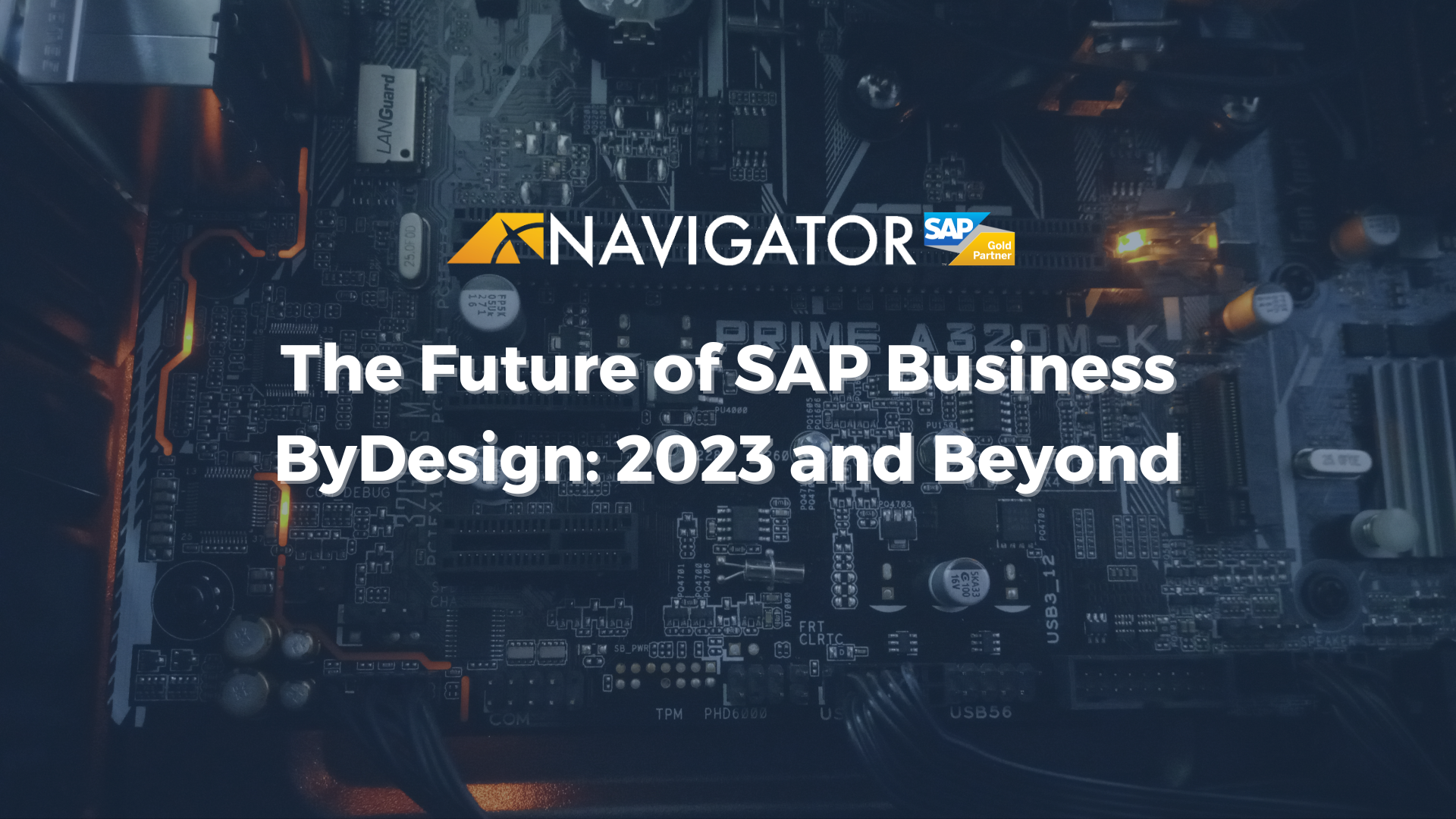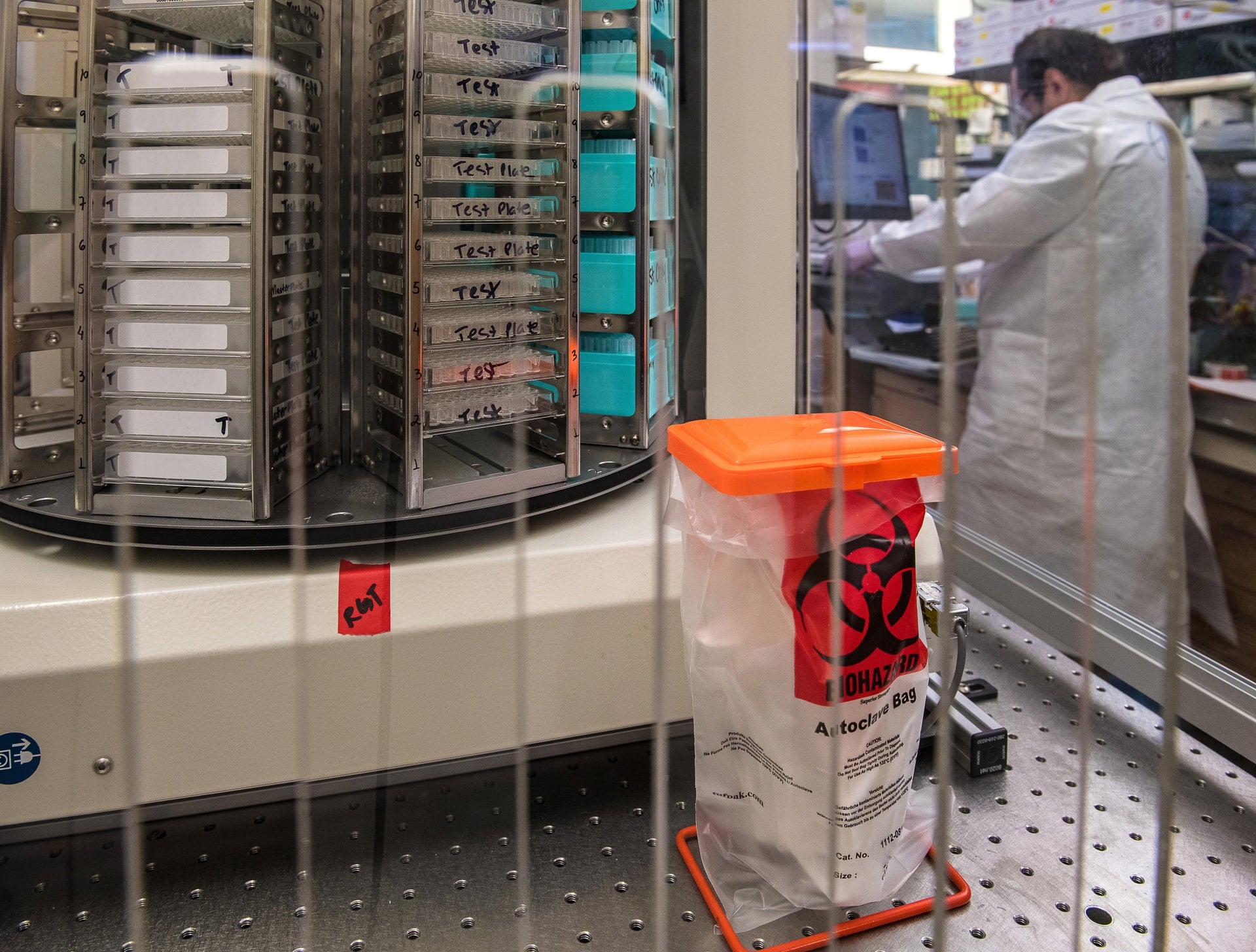What is UBIX?
UBIX is an Advanced Analytics and AI Platform designed for the business user. The general-purpose platform can address any number of use cases from the front office to the back office, such as customer analytics, financial analytics, HR analytics, demand forecasting, procurement, and more.
UBIX integrates with SAP Business One, SAP Business ByDesign, and other SAP applications to bring the power of data and advanced insights to your ByDesign instance.
In this webinar, see how to model your existing ByDesign data into strategic actionable information. We'll show how layering in external data can create dynamic new business insights.
Have questions? Email info@nbs-us.com or call (801) 642-0123.
[TRANSCRIPT]
Ralph Hess: (00:00)
Good morning everybody. My name's Ralph Hess, Executive Vice President, Sales, Marketing, and Pre-Sales here at Navigator. Thank you so much for attending our webinar this morning. We're extremely excited about our partnership with UBIX which really is exciting as you'll see today. We're all very aware that ByDesign has very strong analytic capabilities, providing you insight into your data. What UBIX is gonna really do is allow you to take that to the next level and really derive some intelligence out of that data that you've been spending your time very meticulously collecting and going through and analyzing. I think you're gonna find this a fascinating webinar. As you have questions, again, please pose them in the question area of the webinar, and we're gonna be happy to either pose those to the team or we'll just kind of collect them and we'll ask the questions at the end. So, without further ado, I'd like to turn it over to the UBIX team.
Miles Mahoney: (01:12)
Thanks, Ralph. Welcome everyone. My name is Miles Mahoney. I'm the Chief Revenue Officer at UBIX. Let me say we're thrilled and excited to be here today in partnership with Navigator, really to describe how by design customers, all of you can easily leverage advanced analytics capabilities from UBIX in partnership with Navigator. Two, really unlock business value across your enterprise, especially during these inflammatory and very turbulent times. So you'll see more and more detail, during the UBIX's overview, how each and every one of you can benefit from UBIX. I want to emphasize this is no longer a billion-dollar company opportunity. This is really an opportunity for all of you, for all companies, who to a large degree have been left behind during this kind of revolution. So today we're gonna cover UBIX in more detail.
Miles Mahoney: (02:10)
We're gonna talk about some use cases that we believe are pertinent to every one of you. We're gonna talk about pricing and next steps. But before we jump into this, I, I wanna say, I, I hope there's three takeaways from, from the webinar today. Uh, the first is that you, you know, our mission is to put AI in the hands of companies of all sizes. I, as I said before, so that you can really begin to benefit from the same business insights that larger organizations have benefited from, either because they've staffed in a large data science organization, or they've been able to afford, you know, costly solutions like aws. The second is leveraging tools that can give you better insight to your existing data and the ability to enhance that data and help you navigate, uh, you know, today's uncertainty. You know, shockingly, only 25% of your company's data is ever used for decision analysis, but right, we wanna shift that on its head.
Miles Mahoney: (03:10)
We wanna leverage that 75% to help you make better, faster, and more productive decisions. And then the third is, you know, with uic, you we're, we're gonna, and in our partnership with Navigator, we're gonna take a crawl, walk, run approach to adopting the best of ai. So in partnership with Navigator, we're gonna help you navigate your prior to use cases and your AI roadmap to drive growth, take cost savings out where needed, but mo most importantly, to enable you to scale and grow your business. So let's start out with, you know, who, who, who is uic? UIC is a no code data science and AI platform allow, you know, to allow business users and subject matter experts to solve complex analytic problems without relying on data. We manage the entire AI life cycle, and we automate and scale that across the enterprise. And maybe most importantly, when you are able to solve very complicated problems, the idea that there's reusability and applicability for that given use case, certainly will not only be a huge benefit, but it'll allow you to scale and share some of those best practices across your respective organizations.
Miles Mahoney: (04:30)
So, modern business systems like sap, like your by design products are, they're providing a flexible on demand digitization of your core business operations. Driving towards what I believe we all hope is that digital transformation, we help you modernize and future proof your E R p. So with the advent of data science and advanced analytics organizations can now analyze unprecedented volumes of data from disparate data sources, faster, continuously, and more, a cost effectively, really to drive new insights throughout your departments and your organizations. And we, along with sap, we call this the era of the intelligent business, where intelligent processes and applications tap into both internal and external data sources to generate new insights in foresight that drive intelligent action for greater business impact. UIC helps you create the intelligent business by transforming the way you measure, monitor, and analyze operational and financial data to drive timely, more effective decision making.
Miles Mahoney: (05:41)
Your E r P alone can't get you there. So UICs helps you shift from the left side to the right side. So from an overreliance on human intuition and decision making to deriving insights automatically from data to augment human judgment. So for example, if today you create a demand forecast using HU human judgment alone, then with UICs you enable advanced algorithms to create a more accurate demand forecast based on historical data and external drivers, such as weather, consumer price, indices, dun and Bradstreet data. Not only are the machine generated forecast more accurate, but when done well, they can remove bias that is often found in HU human judgment. So you reconcile human judgment with machine generated forecast, make adjustments and submit the final forecast to the plan of record. So w with uic, you shift from an overreliance solely on historical, internal only data in decision making to now augmenting historical data with external causal drivers to create new insights that drive business impact.
Miles Mahoney: (07:03)
So why is this important? Why now and why UICs? Well, the short answer is unprecedented volatility, uncertainty, and risk. I think we all know in a world where inflation is off the charts, demand for product is uncertain, supply is certainly at risk. In incom input, commodity prices are highly volatile. Every company, every by design customer needs new advanced analytics tools to augment their E R P and complement your capability to anticipate in shape business outcomes more effectively. And let me add, without the need or support from it, right? Traditional e r P and by design is no, no ex no exception. And reporting tools alone cannot address the analytic opportunities that exist from the front office to the back office, from customer analytics and demand forecasting to production and procurement, UIC integrates and extends SAP by design to empower all of you, all of the business users to address these high value analytics challenges with data science and advanced analytics like never before.
Miles Mahoney: (08:20)
So as I mentioned, UIC is a data science platform that manages the end to end AI life cycle, and it bridges the gap between the business users and the data scientists. So while other AI platforms focus on data scientists, UICs focuses on the domain and the line of business experts. We believe that until the domain expert brought into the analytics process, AI will not be abundant, it won't be reliable, and it certainly is not gonna be cost effective. Best case, it's one and done, and it's really a very costly endeavor With UIC companies can now leverage by design your existing infrastructure, combining both e r p data and external data, as I mentioned, commodity indices data, weather data. We have over 250 connectors to companies like Salesforce, ServiceNow, and many others. To generate new insights for faster, better decision making, specifically our platform ingests and assembles internal and external DA data, we enable business users to Lev Le leverage pre-built analytics solutions and put them into production. These solutions then create new inferences in predictions and pass those on to the appropriate end user application. So for you, that might be SAP's BI solution or sac, uh, or even a third party solution like Tableau or click, we don't care, it's up to you. This way, AI enabled processes and applications can be built quickly and cost effectively to deliver timely, reliable foresight in intelligent action. We help you become smarter without hiring expensive, hard to find talent.
Miles Mahoney: (10:09)
So because UIC is a general purpose data science platform, we address any number of data types and use cases from the front office to the back office. So here's just a few accounts receivable, collection analytics. So a company can model consumer attributes such as firmographics and payment history to infer the likelihood that one of its customers who has missed a past due invoice to pay in the next period. So by segmenting customers, the account's receivable team can optimize resources to improve collections and reduce collection cost. So segment C is unlikely to pay. They can be sold to an outside collection agency, as an example, Segment B may pay, so their sent of phone call and then segment A is very likely to pay their sent emails. So you can kind of get the sense of whether it's accounts receivable collection, whether it's sales pipeline conversion modeling, demand forecasting, or asset monitoring. And predictive maintenance. UICs can help you achieve your goals of addressing high value use cases in a very predictable manner.
Miles Mahoney: (11:21)
So here's a real life customer example. Let me just share this with you. This is a $300 million meat processor in the Midwest. They convert beef, pork and Turkey proteins into various products, uh, for sale into two markets. The first is the restaurant market, which has experienced a significant decline during the pandemic and the specialty food, retail, and distribution market, which has seen significant growth. So a new CFO joined the company about two years ago to drive digital transformation. He replaced their legacy e R P and started to build out an analytic foundation. This is when we met the cfo and he told us that their number one business challenges how to cope with input commodity price volatility. So as companies caught in the middle, on one hand, they buy proteins on the open market. On the other hand, large retailers are putting pressure on price, something that many of you are experiencing in your own businesses, and he wants to use UIC to help his procurement team make better buy decisions.
Miles Mahoney: (12:28)
He realized that his current new e r P is missing a critical component, namely the data science platform to combine both internal procurement data with third party commodity index data to create models that forecast commodity prices going forward. The output of UIC will feed their new e r p and reporting module as part of their analytic workbench. So we are pursuing two use cases in this customer. The first will be a reliable commodity price forecast using third party data in historical internal procurement data. The second use case, which we didn't anticipate, uh, which was a nice byproduct, is we'll tackle the demand forecast. So to create a more reliable demand forecast. And once we have quantity from the demand forecast and price from the price forecast, we can make more reliable procurement, uh, decisions, uh, and recommendations. And as you can see from the business value, it is significant.
Miles Mahoney: (13:29)
Uh, I think this was shocking for the CFO and the CEO of this company. A 3 cent savings per pound in procurement was worth about a million dollars of annual procurement savings. And what he described for us is, hi, his quote was, This is game changing and it drops to the bottom line. So the ROI of advance analytics is ver is substantial. And this example I just gave you is describes if your analytic foundation really is, uh, in place the idea that you can accomplish many of the, the, the goals that you wanna accomplish. They're absolutely, uh, possible. So the, the, the, the meat processor example is just one case study that underscores the reason that AI and advanced analytics is so important. Uh, it establishes an analytic foundation for you to crawl, to walk, and then to a run to run. And at the heart of our strategy is to deliver value quickly and affordably.
Miles Mahoney: (14:29)
And that starts with our solution library. What you're looking at right now and through our own efforts and those of our partners, we have access to hundreds of, of analytics solutions in a range of industries, from retail to industrials, to energy to financial services and manufacturing. Many of these were built and have been in production for over 20 years. So if one of your, your use cases can already be addressed by one of our models, then the time to value is very fast. And if it's first of a kind and it's never been kind of addressed, then the model can be built quickly with UICs and navigator as your partner. So UICs and its model library provides you really at your own pace. The crawl, walk, run approach that I talk talked about an AI roadmap to drive further and future value for your respective companies. So for instance, you can start with addressing demand planning opportunities, then you can migrate into global capacity planning, then production planning in a plan, and address safety, stock levels and procurement, uh, even predictive maintenance and equipment in a factory floor. The opportunity for you to drive value on your own timeline is endless.
Miles Mahoney: (15:48)
So let me go to demand planning as a kind of a deeper dive example. So this is a great place to start, really for all hard good industries from manufacturing to distribution and retail. Now, some of you are using traditional statistical methods, forecast methods, uh, to, to, to drive business. And these are largely based on history, right? This methods mess, this message, this method may be adequate at handling fast moving items, but, but it really doesn't work in a complex volatile demand pattern. So demand is impacted by external drivers such as local weather forecast data, foot traffic data, or local demographics, uh, consumer taste, and even social media. So human judgment alone cannot cope with the volatility, the uncertainty, and the risk. And especially going forward, I think as we've all experienced with covid, the way in which we're gonna look at demand, whether that's inputting, uh, uh, market conditions, unemployment conditions, they are all gonna have an impact on how we make decisions going forward.
Miles Mahoney: (17:01)
UIC uses data science to combine external and, and internal data. It really does avoid overfitting the data by minimizing or recruiting out factors that have no demand impact. The solution can apply data science not only at a product store level, channel level, but also at different levels of aggregation. So for example, a a product region or a product chain, uh, and with flexible grouping grouping. So the, the, the value opportunity here is significant. So imagine the reductions in working capital requirements. If a company could improve its forecast accuracy by 10 to even 40% and increase inventory turns by 10 to 20%, the ROI in many cases is less than 120 days. And each and every model that you deploy thereafter pays for itself.
Miles Mahoney: (17:58)
So we talked a little bit about field service. Uh, you know, really, again, the, the, the challenge here is most organizations operate into what they call a break fixed model, uh, which honestly just it, it doesn't work. What UIC does is it provides the ability to capture, digest, and derive actionable insights from data that is critical in modernizing field service organizations. So intelligent predictive systems driven by UICs can automate manual time consuming tax tasks, like collecting data, diagnosing problems, and even identifying the best solution to resolve issues. So UIC optimizes resource management. It empowers field teams through, you know, mixed reality and mobilization, and it improves customer service with proactive and predictive service. So in short, UIX is providing organizations with the ability to optimize every facet of field service delivery.
Miles Mahoney: (19:09)
So pricing, as we talked about this is, you know, our goal was to make this affordable for companies of all sizes, not just the billion dollar plus organizations. So ideally, as you can see, we've got kind of two components. It's a subscription component to the platform, and then a model, uh, on an all card approach to, uh, onboarding the models if and when you're ready for those given models. So you can get a, a view here of the pricing. Uh, and again, we're working with and through navigators, so if you have any questions on this, they're also happy to answer any questions that you might have.
Miles Mahoney: (19:51)
So, kind of in summary, you know, we're confident that the strategic application of UICs advanced analytics and data science can and will help you and as a by design customer great, you know, gain greater speed, agility, and foresight during these turbulent times. And who knows when these turbulent times are gonna end. So the call to action here for all of you would be reach out to your navigator rep to schedule a discovery call, um, with UIC and Navigator. So I hope today you have a better understanding of the compelling value that UIC can bring each and every one of your businesses, the opportunity of applying advanced analytics from the front office to the back office, from customer analytics, to financial analytics, to demand forecasting, inventory allocation and replenishment procurement and more. So we would like to think about this as you know, let's prioritize one high value use case. Reach out to the navigator team to Jack or Kevin, and schedule that to do a deeper dive into that use case to define the scope of work to kick off a project. And let's see how these results, the ROI of uic, how that can begin to transform the way you do business. So in closing, the opportunities are endless, the ROI is significant, and we look forward to working with each and every one of you. Thank you.







